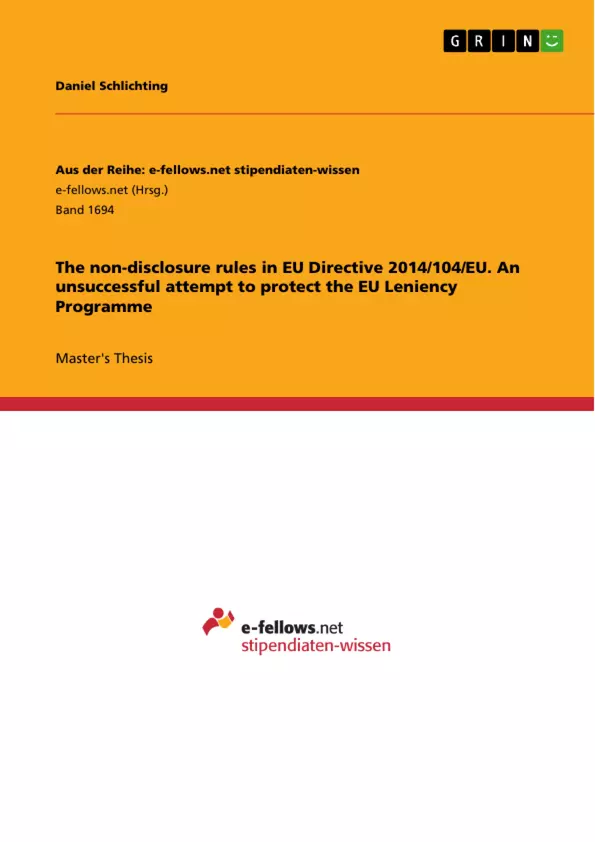The European Union recently enacted Directive 2014/104/EU on “certain rules governing actions for damages under national law for infringements of the competition law provisions of the Member States and of the European Union” (Damages Directive). One of the main purposes of this directive is to balance private and public competition law enforcement, particularly to solve the tension between the Commission’s leniency programme and private enforcement. The tension between these two institutions is caused by the fact that potential leniency applicants might be discouraged from applying for the programme if the danger exists that they could find themselves in a worse position than non-applicants in relation to potential damage actions against them. It can be noted that there are generally two ways of solving this tension: (1) to prevent disclosure of leniency material from potential damage claims and (2) to reduce the amount of damages successful leniency applicants have to pay. The EU legislator decided to combine both methods and implemented three provisions to protect the leniency programme. These are the Articles 6 (6) (a), 7 (1), which take the first way, and 11 (4), which limits the damages successful applicants have to pay to the ones suffered by direct or indirect customers and cartel victims which could not obtain damages from other cartelists. Additionally a new Art 16a (2) was very recently (3 August 2015) implemented into Regulation 773/2004 in order to prevent leniency documents in possession of the Commission from being disclosed. In this essay however, I will focus mainly on the non-disclosure rule of Art 6 (6) (a) Regulation 2014/104/EU since this provision does seem to be most controversial. Nevertheless it cannot be analysed without taking into account the other provisions. [...]
Inhaltsverzeichnis (Table of Contents)
- The non-disclosure rules in EU Directive 2014/104/EU: An unsuccessful attempt to protect the EU Leniency Programme
- I. The need to protect the leniency programme
- II. Art. 6 (6) (a) Damages Directive - an insufficient protection
- III. The consequences of the non-disclosure rule in Art. 6 (6) (a) from a competition policy point of view
- IV. Loopholes in the provisions of Art. 6 (6) (a), 7 (1), 11 (4) Damages Directive and Art. 16a (2) Regulation 773/2004
- V. A better way to protect the leniency programme: The reduction of damages
Zielsetzung und Themenschwerpunkte (Objectives and Key Themes)
This essay aims to critically analyze the non-disclosure rules in EU Directive 2014/104/EU, specifically focusing on Article 6 (6) (a), and assess their effectiveness in protecting the EU Leniency Programme from the negative impacts of private enforcement. The essay explores the tension between private and public competition law enforcement, particularly the challenges posed to the leniency program by potential damage claims against leniency applicants.
- The EU Leniency Programme and its importance for effective competition law enforcement
- The tension between private and public enforcement of competition law and its impact on the leniency program
- The non-disclosure rules in EU Directive 2014/104/EU and their effectiveness in protecting the leniency program
- The flaws and shortcomings of the non-disclosure rules in the Directive
- Alternative approaches to protecting the leniency program while facilitating private enforcement
Zusammenfassung der Kapitel (Chapter Summaries)
- The first chapter of the essay introduces the tension between public and private enforcement of competition law and highlights the importance of the EU Leniency Programme for effective competition law enforcement. The chapter also explains the risks posed to the leniency program by potential damage claims against leniency applicants.
- The second chapter focuses on Article 6 (6) (a) of the Damages Directive, the primary non-disclosure rule, and its effectiveness in protecting the leniency program. The chapter discusses various arguments against the provision, including its inconsistency with ECJ case law and its potential for undermining the program's efficiency.
- The third chapter examines the consequences of the non-disclosure rule from a competition policy perspective, highlighting the potential drawbacks of such a rigid approach. The chapter explores how the rule might hinder efficient competition law enforcement and limit the effectiveness of the leniency program.
- The fourth chapter discusses the loopholes in the Directive's provisions, including Article 6 (6) (a), 7 (1), 11 (4), and Article 16a (2) of Regulation 773/2004, highlighting how damage claimants could still obtain information contained in leniency statements.
- The fifth chapter proposes an alternative approach to protecting the leniency program that involves reducing the amount of damages immunity recipients have to pay. This approach aims to strike a balance between protecting the leniency program and facilitating private enforcement.
Schlüsselwörter (Keywords)
This essay focuses on the intersection of private and public enforcement of competition law, particularly in the context of the EU Leniency Programme. It examines the non-disclosure rules implemented in the Damages Directive, specifically Article 6 (6) (a), to address concerns regarding potential disclosure of leniency information in damage claims. The essay analyzes the effectiveness of these rules in protecting the leniency program and explores alternative approaches to mitigating the tension between private enforcement and the program's efficacy. Key terms include: EU Leniency Programme, private enforcement, public enforcement, non-disclosure rules, Damages Directive, Article 6 (6) (a), competition law, cartel, damage claims, immunity recipients.
- Quote paper
- Daniel Schlichting (Author), 2015, The non-disclosure rules in EU Directive 2014/104/EU. An unsuccessful attempt to protect the EU Leniency Programme, Munich, GRIN Verlag, https://www.grin.com/document/313745




